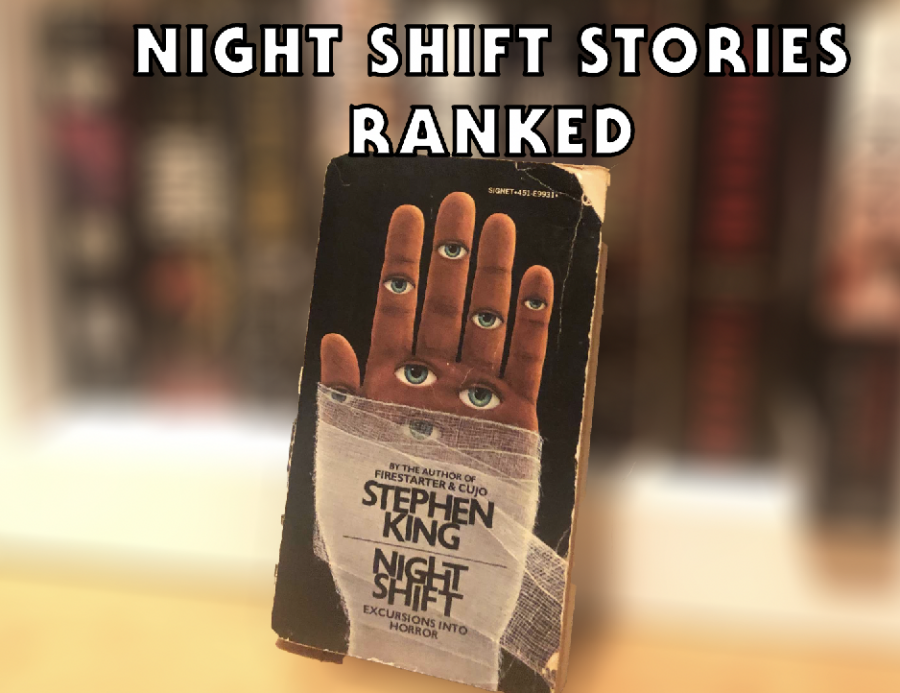Ranking the Stories in Stephen King’s ‘Night Shift’
Zach Maynes and Oliver Barnfield
20 of legendary author Stephen King’s “Excursions into Horror” are presented in Night Shift, but which are the best and which are the worst?
December 7, 2020
In 1978, Stephen King released a collection compiling some of his previously published stories into one volume. It was called Night Shift, and ever since its release King has been known equally as a novelist and a writer of short, spooky stories. In our opinion, Night Shift represents some of King’s finest work and is easily his best short story collection, but it’s not all equal. Like we did with Different Seasons, let’s rank the stories from worst to best.
20. Jerusalem’s Lot
Much of Night Shift acts as epilogues and prologues for King’s novels. ‘Salem’s Lot gets two stories set in the titular town in this collection, and the story that would spawn The Stand also features. It makes sense that ‘Salem’s Lot would be on King’s mind, as that would end up being the blueprint for many of his other books. Carrie may be his first novel but ‘Salem’s feels like the first real Stephen King book. This prequel, however, lacks all the power and energy of its source material. It’s a musty homage to the original Dracula, and its placement is rather unfortunate, as it’s the first in the collection.
19. Strawberry Spring
One of the worst aspects of King’s early writing is his reliance on stories about school shootings or murders around a campus. His worst novel, Rage, uses this storyline to dismal effect and so does this forgettable story. One has to wonder why a young King wrote so much about this subject. Luckily, King grew out of this phase, but going back to these themes in his early work feels a bit awkward.
18. The Man Who Loved Flowers
While this is by far the shortest story in this entire collection, it’s also one of the darkest. Continuing the trend of King’s unfortunate early obsession with young men murdering women in the city, this story starts out very pleasant, but towards the end it hits you with a sudden murder scene, involving the death of a woman lured in by the flowers the serial killer had bought. Overall, this is not as hard to read as Strawberry Spring, but that’s mostly attributable to its shorter length.
17. I Know What You Need
Yet again, early King’s obsession produces another cringe-worthy story. He’s tackled the murder of women in the last two stories, and now this one focuses on some creepy stalker who is using voodoo magic to get his lifelong crush to date him. The stalker is by far one of my least favorite characters I have ever encountered, exemplified best by a scene where the poor girl finds a doll made of her childhood hair clippings, disfigured dolls of her now-deceased friends and family, and a toy car doll that caused a car to run over her previous boyfriend. This story starts off creepy, but by the end, you’ll want to throw the book into a raging inferno.
16. Trucks
One of life’s greatest mysteries is why Stephen King’s only self-directed movie is based on this, one of the most forgettable stories he ever wrote. It’s not terrible but there’s no reason to read or even think about this lame story.
15. I Am the Doorway
While this short story tries to pass as an extraterrestrial horror, it instead comes off as a complete joke. An old astronaut recounts his failed mission to Venus and then reveals how there are alien eyes growing on the palm and fingers of his hands after he was exposed to an alien virus. While King tries to make this sound scary, it comes off as dumb, even more so during a scene where the astronaut is forced to suffocate a kid to death by strangling him with the alien eye-hands. Definitely a recommended read overall, but not necessarily for the right reasons. The primary image is cool and memorable, however, and rightly graced the cover of the paperback edition of the novel.
14. The Last Rung on the Ladder
Much like The Woman In the Room, we have another emotionally resonant story about family relationships. Here we have the story of a man’s relationship with his sister, and it’s one of the most realistic stories King penned. The emotions here feel real and honest, brimming with character and beauty. But it never seems to go anywhere beyond this, and it’s certainly deep but not very enjoyable.
13. The Mangler
This crime drama lightly sprinkles cheesy humor over a strange plot. After an industrial speed ironer sucks in one of the laundry workers that ignored the supposedly foolproof safety switch, two detectives find that a bunch of accidents involving objects being knocked into the machine coincidentally are the keys to a demon summoning ritual, and they need to get rid of it. However, by far the most impressive (and slightly terrifying) aspect of this story is that not one, but three movies were made based on this tiny, 30-page story. As expected, all were terrible. Speaking of which, this collection has had one of the worst track records of King’s catalog when it comes to movies. None of the movie adaptations created from this novel are worth watching, which is quite a shame considering a lot of the stories here are top-notch stuff.
12. Graveyard Shift
One of King’s more gross-out horror tales, this story focuses on the discovery of strange mutated animals deep in the moldy depths of an old textile mill. Avoid this one if you are easily grossed out by descriptive writing and rats. Compared to some of the other stories, this one isn’t too scary. While the plot and ending may be fairly basic, it’s a decent little tale, and well worth the read.
11. Lawnmower Man
Sometimes you have to wonder about ‘ol Stephen. What compelled this man, who has three children and a wife who loves him, to get up and write a story about a naked obese man who eats grass and cats? The Lawnmower Man is utterly ridiculous but is still enjoyable to read, much like The Moving Finger, one of my all-time favorite King stories. Any writer who can successfully write both a gripping tale about dying parents and a story about a fat guy who eats lawn clippings is one talented fellow.
10. Sometimes They Come Back
Stephen King has an obsession with 1950s culture and this obsession has never been more prevalent than here. Despite taking place in the modern-day, many of his stories feature 50s greasers straight out of The Outsiders, and while in his 1983 novel Christine this feels needlessly distracting, here it actually makes sense. The plot centers around Jim Norman, who begins receiving new students who look oddly similar to his brother’s greaser murderers. However, as usual, the ending isn’t satisfying and it just sort of… stops. The rather cliche plot is somewhat predictable, and both this and the underwhelming ending keep this story from truly hitting as hard as it intends to.
9. The Woman In the Room
King is rather underrated when it comes to emotional elements in his work. Sure, his stories may be scary but what keeps fans coming back is his gift for characters that you care about or those who you love to hate. In this case, we see a harrowing account of a man visiting his mother in the hospital. Included as the final story in the collection, King writes it in an intimate style that fits the somber story like a glove. It’s not what you would exactly expect from this collection, but King kept up a bit of a tradition when he included a similarly somber story at the end of Skeleton Crew, his next collection in this style.
8. The Ledge
This is a truly thrilling tale, and it is one of the best showcases of King’s ability; he can make one simple idea into a great story. After his wife gets into an affair with the local tennis pro, and an offscreen chase scene at the airport, Mr. Cressner kidnaps the tennis pro and offers him a decision. Either shimmy along the tiny, 5-inch edge of an apartment building, a few hundred feet up, above the abyss of the city below, or get framed by planted drugs. If the tennis pro makes it around the building, he gets some money and Cressner’s wife. If he loses… well, it’s lights out. The writing is tense as the pro struggles to survive on the icy cold, windy ledge, and the twist ending elevates the story to Olympian heights.
7. Gray Matter
Gray Matter is a pretty straightforward tale with a gory and inventive tone. It’s one of King’s most readable stories and while it may not be anything deep, it’s nonetheless memorable and fun. However, much like Graveyard Shift, it tends to dip into the disgusting, and this particular tale might make you inspect what you drink before you put it in your body. Certainly one of his most memorable short stories, for the monster he creates alone.
6. Battleground
This story, involving a professional assassin who gets his comeuppance, is a fresh blend of comedy and horror, leaning heavily into the slapstick genre. After his last murder, Mr. Renshaw receives a mysterious package, which turns out to be a bunch of toy army men. After he inspects it, they suddenly all come to life, Toy Story style, and start attacking him, and it’s hilarious but also incredibly interesting watching him try to deal with their tiny weapons and antics. The ending is the best part and closes the door perfectly on a fun, wacky tale. One of King’s most hilarious works for sure. Action-packed stories like this and The Ledge present us with a rare side of King, one that deals in less horrific tales that take place in isolated locations. Those who think King isn’t versatile should seek this one out.
5. One for the Road
King yet again returns to the world of ‘Salem’s Lot for a story that’s far better than the other adjacent ‘Salem’s tale here. Instead of being a prequel, this story is instead a sequel to the original novel. Here, the protagonists come across a family within the town of ‘Salem’s Lot who have been afflicted with a vampiric disease. It ends on a chilling note and is one of the most viscerally disturbing stories King ever wrote.
4. Quitters, Inc.
Rehab gone wrong; Quitters, Inc. truly makes you consider how far you would go to stop an addiction. It’s the chilling tale of a strangely powerful company that will do literally anything to make you quit smoking. Not only will you be monitored for the duration of your rehab, but no one you care for is safe. No matter what you do, you will have to quit eventually, or else the punishments will never end. Even those with exceptionally strong addiction are cured… by death. The similarly themed Gray Matter also deals with addiction but in a rather simplistic way. The man who drinks too much turns into a big pile of gloop and we don’t get much beyond that. But Quitters, Inc. turns the tables and makes those trying to stop the addiction the bad guys, although they are ostensibly doing the right thing. It’s a morally complex concept that never tapers and ends on a biting twist. One of King’s most gripping short stories, Quitters, Inc. is truly a great read.
3. Night Surf
Night Surf is a story whose concept would eventually evolve into The Stand, one of King’s best and also worst books. The Stand has some very strong scenes and is definitely one of his most memorable novels, but it falls apart in the second half and suffers from severe bloat. This story, however, is all killer and no filler. It’s written in an impressionistic style that provides the reader with some chilling and beautiful imagery. It’s a stunning story that is equal to a lot of the writing in The Stand.
2. Children of the Corn
The legacy of Children of the Corn has been somewhat overshadowed by the endless stream of movies released based on the source material. However, as bad as those films may be, it’s important not to overlook the fantastic original. Children of the Corn, like most of King’s stories, is extremely simple. But King’s powerful prose and realistic dialogue elevate it to a higher status. Lots of King’s stories deal with evil children, most notably Pet Sematary, and both are powerful stuff. Here, a young couple uncover a cult of kids in an empty town who want to sacrifice them. Skip the movies and read this instead.
1. The Boogeyman
The Boogeyman is a short story that shakes you to the core. Much like his masterpiece Pet Sematary, it revolves around the death of a child. Most writers use the death of kids for shock value, but King is such a strong writer that he makes it seemll too real. His gift for description here is also unmatched by any other writer, putting you inside the head of its paranoid protagonist. King isn’t known for his great endings, but the shocking twist featured here is fantastic. The Boogeyman is a slender story but it makes up for its short length with an unforgettable storyline and a bone-chilling conclusion. If you can only read one short story from this collection, read this.





Chris • Oct 22, 2023 at 1:57 am
You’re reviewing based on your own personal taste in content, on whether you like the subject matter of the story or not. I don’t care about your taste. I want to know if the story succeeds in what it tries to convey. The fact that you have The Boogeyman as #1 and Strawberry Spring at #19, I can’t even.
Tufunfa • Jan 2, 2024 at 10:33 am
Of course they are reviewing based on theis personal taste, whose taste would they use, yours? Go make your own list then, and stop complaining. Sheesh
Jonathan Cardwell • Feb 23, 2025 at 8:18 pm
Ya, I’m with Tufunfa here. What were you expecting when you clicked on this?
Kim • Sep 22, 2022 at 4:39 pm
Maximum Overdrive is a classic movie. AC/DC and all!
Chris • Nov 27, 2021 at 11:53 am
Never liked the ending of The Boogeyman. Too sudden. Ruins the rest of the story. The Last Rung on the Ladder is a truly beautiful story. Night Surf should be much lower.
None • Nov 20, 2021 at 12:31 pm
Bad ranking and worse explanations.